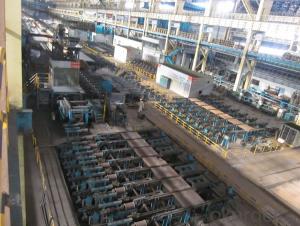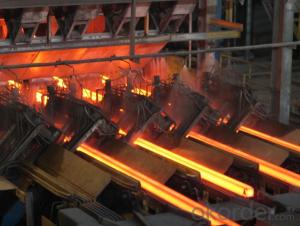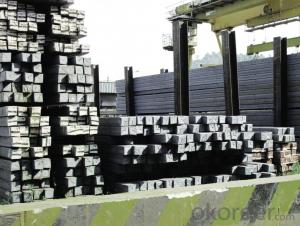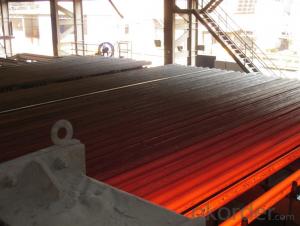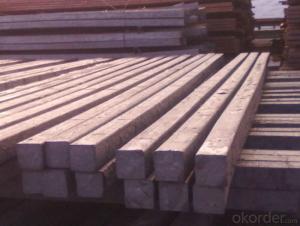Prime Q275 95mm Square Alloy Steel Billet
- Loading Port:
- Shanghai
- Payment Terms:
- TT OR LC
- Min Order Qty:
- 100 m.t.
- Supply Capability:
- 10000 m.t./month
OKorder Service Pledge
OKorder Financial Service
You Might Also Like
Structure of Prime Q275 95mm Square Alloy Steel Billet

Description of Prime Q275 95mm Square Alloy Steel Billet
1. Prepainted steel coil is coated with organic layer, which provides higher anti-corrosion property and a longer lifespan than that of galvanized or galvalume steel sheets.
2. The base metals for prepainted steel coil consist of cold rolled, HDGI Steel, electro-galvanized and hot-dip alu-zinc coated steel. The finish coats of prepainted steel coil can be classified into groups as follows: polyester, silicon modified polyesters, polyvinylidene fluoride, high-durability polyester, etc.
3. The production process has evolved from one-coating-and-one-baking to double-coating-and-double-baking, and even three-coating-and-three-baking.
4. The color of the prepainted steel coil has a very wide selection, like orange, cream-colored, dark sky blue, sea blue, bright red, brick red, ivory white, porcelain blue, etc.
5. The prepainted steel coils can also be classified into groups by their surface textures, namely regular prepainted sheets, embossed sheets and printed sheets.

Main Feature of Prime Q275 95mm Square Alloy Steel Billet
Uncoated CR steel sheet
With the features of in line with the international highest standards in demension and shape, excellent surface finish and properties, the products are mainly used in home appliance and automobile industries.
Galvanized steel sheet(include HDG and EG)
With the features of good corrosion resistance, the products are mainly used in automobile, home appliance, electronics, building and machinery manufacture industries, etc.
Precoated steel sheet
With the features of enviromental protection and good processablility, long lasting surface durability, rich in colors, the products are maily used in building, home appliance and furniture industries, etc.
Applications of Prime Q275 95mm Square Alloy Steel Billet
A. Corrugated design makes it excellent waterproof performance
B. Materials as prepainted steel sheets, galvanized steel sheets, galvalume (Al-Zn coated sheets) are available to make corrugated sheet.
C.Those material are durable, anti-corrosion in bad weather for 20-30 years based on it's Zinc(Galvanized) coating or AZ (Galvalume) coating.
D. Different shape of the sheet make it suitable for any style of buildings.
E.Easy to install, no need special tools to fix the sheet.
F.Light weight due to high strength to weight ratio of steel. Light weight means easier handling lower shipping costs, easier installation
G. Different color is availbe base on the RAL Standard make your building more beautiful.
H. We will provide the best solutions if you don't have a exact idea of the specification you want for the steel sheet based on your weather conditions, engineering structure, construction budget and so on.

Specifications of Prime Q275 95mm Square Alloy Steel Billet
Product | Billet |
Material Grade | SGCC / SGCH / DX51D+AZ, etc |
Thickness | 0.6-3.0mm |
Width | 500-1500mm |
Tolerance | Thickness: +/-0.02mm , Width:+/-2mm |
Zinc-coating | Z30-150g/m2 |
Technique | Raw material: Hot rolled steel coil --> Cold rolled_>hot dipped galvalume |
Surface | Dried, Chromated, Unoiled |
Spangle | Regular spangle , small spangle, zero spangle |
ID | 508MM 610MM |
Coil weight | 1-25MT |
Export package | Cardboard inner sleeves, Waterproof paper, galvanized steel covered and steel strip packed |
FAQ of Prime Q275 95mm Square Alloy Steel Billet
We have organized several common questions for our clients,may help you sincerely:
1. How Can I Visit There?
Our company is located in Tianjin City, China, near Beijing. You can fly to Tianjin Airport Directly. All our clients, from home or aboard, are warmly welcome to visit us!
2. How Can I Get Some Sample?
We are honored to offer you sample.
3. Why choose CNBM?
Our delivery time about 15-20days for standard sizes, if you have other requirements like hardness, quanity and width ,it is about 20-40days. But don't worry we also try our best for the delivery time ,because time longer and our cost is higher.
- Q:What are the main factors affecting the heat resistance of steel billets?
- There are several main factors that can affect the heat resistance of steel billets. Firstly, the chemical composition of the steel plays a crucial role. Elements such as carbon, chromium, and nickel can enhance the heat resistance of steel by forming stable oxide layers on the surface that act as a protective barrier against high temperatures. Additionally, the presence of alloying elements like molybdenum and vanadium can also improve the heat resistance of steel by increasing its hardenability and reducing grain growth during heat treatment. Another important factor is the microstructure of the steel. Fine-grained structures tend to have higher heat resistance due to their increased strength and reduced susceptibility to thermal fatigue. Heat treatment processes like quenching and tempering can also alter the microstructure and improve the heat resistance of steel billets. The rate of heating and cooling also affects the heat resistance of steel. Rapid heating or cooling can lead to thermal shock and result in the formation of cracks or distortion in the billets. It is essential to control the heating and cooling rates to minimize these detrimental effects and maintain the desired heat resistance. Furthermore, the presence of impurities or defects within the steel can significantly impact its heat resistance. Inclusions, such as sulfur, phosphorus, and non-metallic oxides, can act as stress concentrators and reduce the heat resistance of steel. Similarly, internal defects like voids, cracks, or segregation regions can promote crack initiation and propagation during thermal cycles, thereby reducing the overall heat resistance of the steel billets. Lastly, the mechanical properties of the steel, such as its tensile strength, hardness, and ductility, can influence its heat resistance. Higher strength and hardness can generally enhance the heat resistance, while excessive ductility may lead to deformation or failure under high-temperature conditions. In summary, the main factors affecting the heat resistance of steel billets include the chemical composition, microstructure, rate of heating and cooling, presence of impurities or defects, and the mechanical properties of the steel. Understanding and optimizing these factors can help in producing steel billets with improved heat resistance for various applications.
- Q:What are the different types of steel billet machining processes?
- There are several types of steel billet machining processes, including turning, milling, drilling, and grinding. Each of these processes involves different techniques and tools to shape and refine the steel billet into the desired form or component.
- Q:What are the main factors affecting the machined surface quality of steel billets?
- The main factors affecting the machined surface quality of steel billets include the choice of cutting tool, cutting parameters such as cutting speed, feed rate, and depth of cut, the composition and properties of the steel billet, and the presence of any surface defects or impurities.
- Q:Are there any international standards for steel billets?
- Indeed, steel billets are subject to international standards. The International Organization for Standardization (ISO) has formulated multiple standards that outline the prerequisites and specifications for steel billets. ISO 683-2 stands out as the most widely utilized ISO standard for steel billets, as it delineates the technical delivery requirements for hot-rolled steel bars, sections, and billets intended for general engineering applications. Moreover, the American Society for Testing and Materials (ASTM) has also established its own set of standards for steel billets, exemplified by ASTM A615/A615M. This particular standard specifies the criteria for deformed and plain carbon-steel bars designed for concrete reinforcement. These global standards ensure that steel billets, produced and traded worldwide, fulfill the essential quality and performance criteria, thereby fostering uniformity and compatibility within the industry.
- Q:What is the role of steel billets in the construction of residential buildings?
- Residential building construction heavily relies on steel billets, which have a crucial function. These elongated steel bars, with their rectangular shape, act as the primary raw material for producing different structural components used in the construction process. One major application of steel billets lies in the creation of reinforced concrete structures. Due to its exceptional strength and durability, reinforced concrete finds extensive use in building foundations, columns, beams, and slabs. To enhance the structural integrity of the building and provide tensile strength, steel billets are employed in the manufacturing of rebar. This rebar is then embedded within the concrete, allowing the building to withstand external forces like wind, seismic activity, and its own weight. Moreover, steel billets find utility in the production of steel beams and columns. These components play a crucial role in supporting the building's weight and transferring loads from the upper floors to the foundation. Steel beams offer superior strength and rigidity, enabling the construction of open and spacious interiors without the need for excessive support walls. This not only provides design flexibility but also maximizes the usable space within residential buildings. Steel billets also contribute to the construction of stairs, handrails, and balconies. These architectural elements necessitate materials with high strength to ensure the structure's safety and longevity. By providing the necessary strength and stability, steel billets enable safe and secure access to different areas of the building. In conclusion, steel billets are of utmost importance in residential building construction, serving as the raw material for various structural components. From reinforced concrete structures to steel beams, columns, and other architectural elements, steel billets play a vital role in ensuring the strength, durability, and overall safety of residential buildings.
- Q:What is the standard tolerance for steel billet dimensions?
- The standard tolerance for steel billet dimensions can vary depending on the specific industry and application. However, in general, the standard tolerance for steel billet dimensions is typically ±0.005 to ±0.010 inches (±0.13 to ±0.25 mm). These tolerances ensure that the dimensions of the steel billets are within an acceptable range to meet the required specifications and standards. It is important to note that different industries and applications may have their own specific tolerances based on their unique requirements and quality standards. Therefore, it is crucial to consult the relevant industry or application-specific standards to determine the precise tolerance for steel billet dimensions.
- Q:What is the average lifespan of a steel billet in the automotive industry?
- The average lifespan of a steel billet in the automotive industry can vary depending on various factors. However, in general, steel billets are typically used as raw materials for the production of automotive parts such as engine components, chassis, and body structures. These parts are designed to have a long lifespan, typically lasting the lifetime of the vehicle itself, which can range from 10 to 20 years or more. The specific duration of a steel billet's lifespan within the automotive industry can also depend on the specific application and the level of stress or wear it undergoes during its service. For instance, engine components like crankshafts or connecting rods may experience higher levels of stress and wear due to the combustion process, potentially requiring replacement or refurbishment after a certain period. Additionally, advancements in material science and manufacturing technologies have led to the development of stronger and more durable steel alloys, further extending the lifespan of automotive parts. These advancements, coupled with regular maintenance and proper usage of the vehicle, contribute to the longevity of steel billets used in the automotive industry. It is essential to note that the lifespan of a steel billet can be influenced by other factors like corrosion, environmental conditions, and the overall quality of the manufacturing process. Therefore, manufacturers and automotive companies prioritize quality control measures to ensure the longevity and reliability of their products. In conclusion, while the specific lifespan of a steel billet in the automotive industry can vary, it is generally designed to last the lifetime of the vehicle, which can range from a decade to multiple decades. Advances in materials and manufacturing techniques enhance the durability and overall performance of steel billets, ensuring their longevity in automotive applications.
- Q:How are steel billets used in the construction industry?
- Steel billets are a crucial component in the construction industry, used in a variety of ways to support and enhance the structural integrity of buildings and infrastructure. These billets, which are essentially semi-finished steel products, are first heated and then shaped into specific forms to meet the desired requirements of construction projects. One of the primary applications of steel billets is in the production of reinforcing bars, commonly known as rebar. Rebar is used to provide strength and stability to concrete structures, such as buildings, bridges, and highways. Steel billets are heated and rolled into long, cylindrical shapes to create these reinforcement bars. Once embedded within the concrete, rebar enhances its tensile strength, preventing cracks and structural failure. Steel billets are also used in the manufacturing of structural steel sections, such as beams, columns, and channels. These sections are vital for constructing the skeleton of a building, providing support and load-bearing capacity. Steel billets are heated and rolled into various shapes and sizes, depending on the specific requirements of the project. These structural steel sections are then assembled to create the framework of the building, ensuring its stability and durability. In addition to rebar and structural steel sections, steel billets are utilized in the production of various other construction components. These include steel plates, pipes, tubes, and wires, which are used for different purposes within the construction industry. For instance, steel plates are used to reinforce the foundations of buildings, while steel pipes and tubes are used for plumbing, drainage, and HVAC systems. Steel wires are commonly used to strengthen concrete structures and as reinforcement in precast concrete elements. Overall, steel billets play a crucial role in the construction industry by providing the necessary raw material for the production of reinforcing bars, structural steel sections, and other construction components. Their versatility and strength make them an essential ingredient in ensuring the safety, stability, and longevity of buildings and infrastructure projects.
- Q:Are steel billets susceptible to corrosion?
- Steel billets can be affected by corrosion. Steel, which is mostly made up of iron and carbon, is prone to corrosion because of the presence of iron. When exposed to moisture and oxygen, a chemical reaction occurs on the surface of the steel, resulting in the formation of rust, also known as iron oxide. This corrosion weakens the structure of the steel and can eventually cause it to fail. To prevent corrosion, protective layers are often applied or anti-corrosion agents are used on steel billets. Common methods include galvanizing, where a layer of zinc is added, or coating the steel with paint or epoxy. Additionally, storing steel billets in dry environments and ensuring proper ventilation can help reduce the risk of corrosion. It's worth noting that the susceptibility to corrosion can also depend on the specific composition and grade of the steel used in the billets. Certain types of stainless steel, for example, contain additional elements such as chromium and nickel, which offer improved resistance to corrosion. However, even stainless steel can corrode under certain conditions, although at a slower rate compared to regular carbon steel. Regular inspection, maintenance, and appropriate corrosion prevention measures are essential in ensuring the long-lasting durability of steel billets.
- Q:What is the typical surface finish of a steel billet?
- The typical surface finish of a steel billet is usually smooth and free from any major imperfections. However, it may have a slight scale or oxide layer due to the manufacturing process.
1. Manufacturer Overview |
|
|---|---|
| Location | |
| Year Established | |
| Annual Output Value | |
| Main Markets | |
| Company Certifications | |
2. Manufacturer Certificates |
|
|---|---|
| a) Certification Name | |
| Range | |
| Reference | |
| Validity Period | |
3. Manufacturer Capability |
|
|---|---|
| a)Trade Capacity | |
| Nearest Port | |
| Export Percentage | |
| No.of Employees in Trade Department | |
| Language Spoken: | |
| b)Factory Information | |
| Factory Size: | |
| No. of Production Lines | |
| Contract Manufacturing | |
| Product Price Range | |
Send your message to us
Prime Q275 95mm Square Alloy Steel Billet
- Loading Port:
- Shanghai
- Payment Terms:
- TT OR LC
- Min Order Qty:
- 100 m.t.
- Supply Capability:
- 10000 m.t./month
OKorder Service Pledge
OKorder Financial Service
Similar products
New products
Hot products
Hot Searches
Related keywords
